“In order to meet customers’ needs and exceed their expectations, do we need to invest in developing and improving government service centers in the UAE?”
A question that occupies the leadership’s mind in every government entity in the UAE. The story began in 2013, when UAE leaders started the digital transformation journey by setting an ambitious target of shifting to an efficient and customer-centric government. At that time, the target was to provide all government services through mobile devices, accordingly all government entities invested in automation and integration and in how to provide services to customer through a new channel (E-services).
By May 2015, His Highness Sheikh Mohamed bin Rashid Al Maktoum, UAE Vice President and Prime Minister and Ruler of Dubai, announced that 96% of government services had been delivered successfully via mobile devices. That was a remarkable achievement for entities, and a substantial leapfrog for the government services innovation in the UAE (How the UAE government modernized citizen services, Mckinsey reports 2016).

Source (How the UAE government modernized citizen services, Mckinsey reports 2016)
His Highness Sheikh Mohamed bin Rashid Al Maktoum set a new target for 2018; 80% of those who use government services should access those services via mobile devices. The target was about how to shift customers from going to service centers towards using smart and online services instead.
The new challenge is not only focusing on digital transformation but also on changing customers’ preferences, attitudes and behaviors when it comes to government services.
Educating customers in the UAE about new service is an important part of marketing. However, with 202 nationalities living in the UAE, customers have different service delivery background, and their needs and preferences are complex. So, it would take extensive effort to let customers understand the value and benefits of the new services.
The new target put a great deal of pressure on government entities; how to ensure successful digital transformation while maintaining the e-adoption from both entities and customers. With this in mind, the future of the service centers was always uncertain.
Should we invest more in service centers? Should we close them altogether? Should we reutilize them in other purposes like training or quality control units? Those questions were often asked by the government leadership.
While exploring customers’ needs and preferences in the UAE, several studies found out that:
– Customers still prefer the human element in service delivery. They want to talk to someone who answers their questions. Talking to a customer service agent makes them feel more comfortable.
– ‘Blue collars’ is a segment of customers who still prefer the traditional way of personally visiting service centers to drop and collect the documents of a given transaction.
– ‘Elderlies in UAE’ enjoy filling their time by visiting service centers and talking to people during the service provision.
– In a retail world, customers prefer to visit stores and service centers to check and try products before purchasing them.
With anything and everything purchased now online, traditional businesses have been disrupted which raised the question about how we can utilize the dead stores?
SingTel digitally-augmented stores are a clear manifestation that service centers will never die and that we are moving towards a new era where service centers become a new channel providing customers with a new value (Retail’s not dead. Welcome to the era of the digitally-augmented store, a report by Singtel).
SingTel introduced a hybrid approach where both online and offline touchpoints are combined to provide the best customer experience with a highly personalized service.
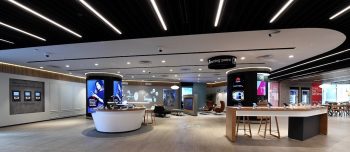
Source (Retail’s not dead. Welcome to the era of the digitally-augmented store, a report by Singtel)
Below are key features of the new digitally-augmented stores, where the best of the digital services and in-person services are blended together to provide the perfect customer experience.
1. Queuing the smart way with an intelligent WiFi-based queue system:
The simple way of providing a queue number is to login the store free WiFi, where customers receive a clear update on their queue status and at the same time watch live TV streaming on their devices.
This might look simple although the benefits could be great. Through the login information, Singtel is able to identify customers using their phone numbers, retrieve their history, their preferred devices, and their latest online transactions from historical records. This can perfectly give a clear picture to the agent about the customer and enable him to personalize the service offered to them.

Source (Retail’s not dead. Welcome to the era of the digitally-augmented store, a report by Singtel)
2. Advanced crowd and data analytics:
Using the smart WiFi network and the customer location, position and movement inside the store, supported by store cameras, the service center manager is able to analyze the real-time traffic of customers. This could help store managers to choose the right products to show and to reutilize their resources.
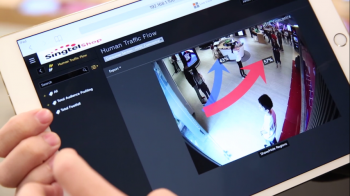
Source (Retail’s not dead. Welcome to the era of the digitally-augmented store, a report by Singtel)
3. Seamless instant self-checkout and digital self-service facilities:
The store offers a nine-meter display wall, which allows customers to try out latest models and accessories and even buying instantly with scanning the product QR code and automatically the product anti-theft RFID is disabled and the customer can grab the device and go with a smooth and automatic checkout.
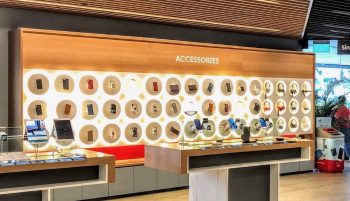
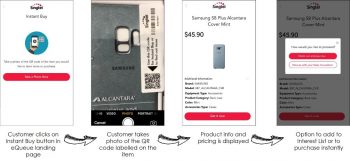
Source (Retail’s not dead. Welcome to the era of the digitally-augmented store, a report by Singtel)
The store is also offering different kiosks for online services that allow customer to pay bills, card top-ups and SIM card replacements.
With smart lockers, customer can also collect their online purchased devices 24/7 through entering their product number and verification code.

Source (Retail’s not dead. Welcome to the era of the digitally-augmented store, a report by Singtel)
4. Live Bots – Smart employees:
Through ipads, connected to live employees, Singtel is offering a new channel to assist customers in remote service delivery through a customer agent located in another store with less customers or an agent on the contact center. It’s simply a video call that can help customers get what they need in a smart way.

Source (Retail’s not dead. Welcome to the era of the digitally-augmented store, a report by Singtel)
5. Intuitive product discovery:
With products connected to sensors empowered by IOT technology, devices with smart touches and cameras, each counter can provide analysis on how customers perceive the product, how many seconds do they need to try it and it also provides customers with useful information to help them take a decision, such as product information, comparisons and price.
6. Transformed event space:
With a great fit out located in the middle of the store with a 7-meter LED video wall and a convenient seating area, the space can be used as a waiting area for watching TV programs. It can also be readily converted to a space for special events such as launching a new product and holding press conferences or e-game tournaments.
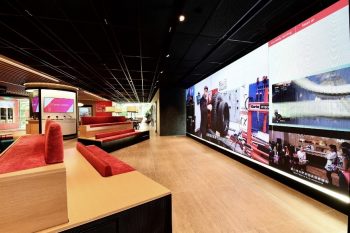
Source (Retail’s not dead. Welcome to the era of the digitally-augmented store, a report by Singtel)
In fact, this center registered an increase of 30% in store traffic, a significant boost in staff productivity, and an increase in customer experience scores as high as 97%.
The above example is not the only one. In Dubai, Apple has applied the same approach by opening a new store in Dubai Mall – Burj Khalifa with a fabulous view on the fountain and with a fit-out that transforms the customer journey in a very positive way.
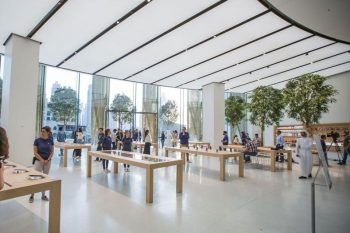
Source (www.apple.ae)
The way forward for UAE government is to transform the service centers to a new channel:
– A channel that can offer new experience with mix of the human touch and the highly smart systems.
– A channel that can be used as a service lab, where it can provide services and at the same time collect customer insights and feedbacks about services and products.
– A channel that can provide smart services through integrated systems and proactive approaches.
– A channel that can be very cost-efficient and that can utilize resources efficiently.
To enable this, the UAE government entities might adopt different techniques such as:
1- Enabling more technologies, such as IoT, face recognition techniques, cognitive intelligence modules, and smart and integrated systems. This will help offering smart services with proactive approach, identifying customers from the moment they steps in or call the center, enabling employees to be ready with solutions so that customers can feel that the government is always prepared.
Dubai Airports are using smart sensors in all ceilings before the counters, smart sensors connected to IoT modules that provide headcounts (Customer heat map). Therefore, decision makers can decide to close or open more counters to accommodate customers on the queue.
2- Empowering employees with tools and decisions, so that they can solve problems on the spot.
Seoul Airport, Ritz Carlton hotels and Disney land are pioneers in that. With dedicated petty cash for all customer service agents and clear delegation of authority, employees can do their best to create unforgettable customer journey.
3- Providing a one-stop shop where customers can find all related services under the same roof. This is commonly known now as service bundling. UAE, Malaysia, Estonia, Finland and Singapore took the lead in this. From the moment you step in to renew your car registration, you will find all related services around, starting from car inspection, licensing, insurance, mechanical repair, body and engine technician.
4- Acting efficiently by utilizing human resources. Dubai Police are now transforming all their police station to smart police station (SPS), with smart kiosks equipped with video conferencing function. Customers can go to any SPS and open a case while the agent who is providing the service is located somewhere else accommodating less customers.

Source (gulfnews.com)
5- Using service centers as future labs for testing new services, products, bundles and using feedbacks to enhance and improve the service.
In a nutshell, service centers and stores will never die, and I am positive that service centers in UAE government will adopt a futuristic approach that can better utilize the existing centers and benefit from the new technologies to deliver a great customer experience.



